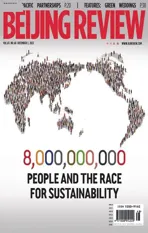Adding Impetus to Low-Carbon Transition
2022-12-26ByMathewWong
By Mathew Wong
As many governments worldwide signed and committed to the Paris Agreement in 2015, there is now an overarching goal of slowing down global warming and controlling greenhouse gas emissions. The agreement aims to limit global warming to well below 2, preferably to 1.5,degrees Celsius, compared to pre-industrial levels. In recent years, green investment has gained international prominence as an efficient way to mitigate the impacts of climate change.
However, a lingering concern surrounding this plan’s success is how such a collaboration-heavy goal can be materialized among countries with diverse backgrounds,needs and contexts, especially given the need to balance economic development with environmental protection against a backdrop of keen competition among nations.
In line with its aim of being a responsible major country on the international stage,China has shown its determination to promote sustainable development across a wide range of sectors.
Since its launch in 2013, the Belt and Road Initiative, consisting of the Silk Road Economic Belt and the 21st-Century Maritime Silk Road, has created tangible benefits for participating countries by promoting connections between them. As more countries become part of the initiative while also facing climate change challenges, building a greener pattern for Belt and Road cooperation will help drive the global transition to a low-carbon economy.
By incorporating sustainability into the initiative, China has supported many other emerging and developing economies to develop green and low-carbon power sources to meet their rising demand for energy as well as rapid industrialization and urbanization. Using the initiative as a platform to encourage and support the implementation of sustainable technologies and practices has become an effective means of pursuing a greener planet for humanity in the future.
Since China pledged to end new coal-fired power projects abroad at the United Nations General Assembly in 2021, it has undertaken new initiatives to improve green practices within Belt and Road projects.
In March, China issued a plan that further outlined its key principles, identified measures, and mapped out future directions for the green development of the Belt and Road in the years to come.This document is significant in China’s long-term development and demonstrates its resolve in this regard.
China employs a holistic approach to promoting cooperation across a wide range of key sectors to realize its ambitious environmental goals, ranging from transportation and the clean energy industry to research,development and trade. It also put in place policies to regulate enterprises and promote the lowcarbon transition of coal-powered projects to ensure that its overseas programs become more environmentally friendly.Moreover, several supporting measures are helping facilitate overseas Belt and Road projects to proceed in a sustainable manner,such as offering financial subsidies, setting up open cooperation platforms and establishing efficient systems to prevent and control environmental risks.
Given all these factors, China’s plan for the greening of the Belt and Road is both ambitious and feasible. It offers an explicit and clear direction for all stakeholders to achieve common goals based on their respective positions and strengths. At the same time,the document itself touches upon multiple interrelated aspects of green development,which would amplify its effect if successfully implemented.
While some Western countries are backtracking on environmental efforts due to their vested interests, China instead should continue going further and deeper in promoting green development as an essential component of its domestic development and international cooperation.
China’s actions speak to its vision of long-term sustainable development and its willingness and confidence to confront and overcome ongoing environmental risks as it strives for high-standard, people-centered,and sustainability-oriented progress in the long run. BR
